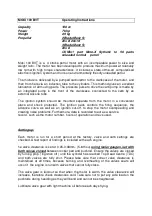
Before initial running, check that the prop bolts are of the correct length for your
propeller, tightened equally and securely, Your tank should be of 26-40 oz capacity
and be fitted with a filter and 1/8 " / 2,5 mm bore petrol resistant fuel line, these items
are available from us.
The ignition battery pack should be 4,8 Volt nicad pack of at least 1.400-1.800 maH
capacity, connect via a two pole On/Off switch, or alternatively via an R/C switch unit
available from us, to the two pole socket on the ignition pack.
Please fit the ignition
switch, as although the ignition back to an idling current when the engine
stops, turning the prop will arm the
ignition automatically.
It is assumed that you have run large petrol engines before, and please mount the
engine with the cylinder between fuel pump and sensor cable uppermost, to a firewall
at least 1/2" thick, using high tensile 5mm bolts, shakeproof washers and blindnuts or
selflocking nuts and large diameter washers . If you choose to make a test stand,
ensure this is FIRMLY anchored to an immovable object such as a building!!!
Please
do not underestimate the power available from the engine!!!!.
Starting:
Ignition switched ON, turn the prop with closed choke flap until the fuel reaches the
carburretor. Ensure your helper has a firm grip on the model and that no curios
spectators are in line with or in front of the prop.
Ignition ON, and holding the prop firmly, turn the prop 2-3 full turns to suck fuel into
the engine. Now with a firm flick, try and start the engine, the engine should fire and
stop, now open the shock flap,
set the throttle just open
and flip the engine over to
start it. Let the engine run at approximately 1.200 rpm for two minutes to warm up.
Thereafter, the carburretor may be finely tuned to suit your propeller by adjusting the
L and H needles on the carb. Please avoid prolonged idling on the ground as this can
lead to overheating due to lack of airflow through the fins.
L needle adjusts the low end mixture, and H adjusts the high spedd mixture. The
conical screw adjusts the idle speed.
Please note that:
1. The L influences the H mixture setting and vice versa. If the engine tries to stop
when throttling up then richen the L screw anticlockwise. The H screw should be
leaned until the engine reaches maximim revs and then backed off an 1/8 turn.
2. Dependent on cowling layout, turbulence with high and low pressure can cause
mixture inconsistencies in flight, causing richening or weakening adjustments of the
mixture to be necessary. Baffling between the cylinders will cure any overheating.



